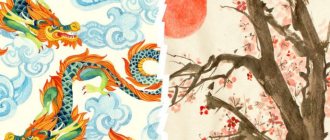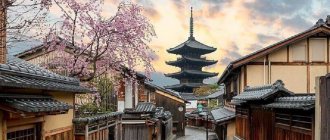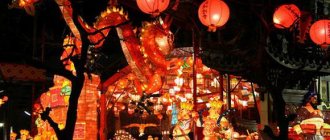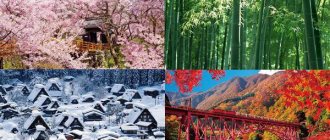Every country in the world, every nation can boast of a considerable number of amazing stories, legends and myths. And among them, the legends of ancient Japan undoubtedly look very unusual and interesting.
This country with an unusual religion and a very specific culture keeps many mystical secrets and legends. You can learn about some of them by getting acquainted with the legends of this country. This article is planned as the first in a series.
The Legend of Urashimo-Taro
In ancient times, on the banks of the Kitamae, there stood the village of Oura, where Urashima-Taro lived. He was young and earned his living by honest work as a fisherman. He lived with his mother, who at that time was considered very old.
The mother loved her son and wished only the best for him, and therefore she began to persuade him to marry. But the son answered her that he was not rich enough to take a wife into the house. Years passed, and the fisherman continued to fish and live a quiet life, without thinking about marriage. But one day a strong wind blew at sea and large waves rose.
The fisherman decided that it was impossible to go to sea in such weather. But he was worried that without fishing he did not earn money and this threatened him and his mother with hunger. He hoped that the next day would be clear and he could catch a good catch.
In the morning the weather actually cleared up, and he set off as soon as he woke up. But until the evening he did not catch a single fish. And when Urasami was almost in despair, a huge fish suddenly bit. He began to pull it and saw that he did not get a fish at all, but a huge turtle.
The fisherman allowed the turtle to grab the stern, but it did not try to swim away and then he decided to let it go. But after a while he came across the same turtle again. And this was repeated several times, and each time he let go of the turtle and continued trying.
At some point, out of nowhere, a large ship appeared in front of the fisherman. From the ship, the helmsman turned to the man and said that he was inviting him to his palace, the daughter of the Dragon, the lord of the seas, the beautiful Otohime.
At first the fisherman refused, because he was worried about his mother. But the helmsman said that his mother would not need anything, and then Urashimo-Taro agreed to go on a visit to the kingdom of the Dragon.
In the beautiful palace they warmly welcomed the young man, held a feast in his honor and dressed him in rich clothes as an important guest. And they began to persuade me to stay with them. As a result, the young man stayed, not for a couple of days, but for three long years.
At parting, the beautiful latrine gave Urashimo a magical casket with three drawers.
He returned to his native shore, but saw that everything had changed. He began asking people and found out that centuries had passed since he went to the princess’s palace. He himself became just a legend, which almost no one remembered.
The saddened Urashimo decided to open the drawer in the box. The gifts that were there turned him into a crane. And he began to circle over his native places. And the beautiful Otohime, in the form of a turtle, climbed ashore to meet him again. So they say and the dance of the crane and turtle appeared.
Text of the book “Myths and Legends of Japan”
Headland Davis Myths and Legends of Japan
Dedicated to my wife
Introduction
Books by authors writing about Japan leave the impression that Japan is a real-life fairy-tale country in the Far East.
We enjoy the beauty and tradition of this country, as well as the love of beauty and adherence to the ancient customs of the Japanese people. We laugh at their way of life, incomprehensible to Europeans, we consider the Japanese woman charming and captivating, despite her unusually bright kimono for the European eye, and we have a vague idea of the integral features of Japan - tea houses, cherry blossoms and geishas. We still listen to the melodic music of the Mikado, but we no longer think of Japan as something like the well-known porcelain plate with a Chinese stencil design. The Land of the Rising Sun became the Land of the Rising Sun, because we learned that its tradition and beauty, its fabulous rites and customs are nothing more than the external manifestations of a great and progressive nation. Today we recognize that Japan is a powerful power in the East.
The Japanese, always a borrowing nation, quickly absorbing and reinterpreting the religion, art and social structure of China and putting their national stamp on what they borrowed from the Middle Kingdom, looked everywhere for material that would strengthen their position and progress. This ability to borrow is one of the most outstanding characteristics of Japan. She was always reluctant to share information with others, but was always willing to access any knowledge that could contribute to her development. In the 14th century, Kenko wrote in his “Notes from Boredom” (“Tsure-zure-gusa”): “When you go on a short journey, no matter where, you seem to wake up.”[1] 1
Quote from the book: Japanese Zuihitsu. St. Petersburg: North-West, 1998. P. 362.
[Close], and the Japanese living in the 20th century put this excellent advice into practice. They travel everywhere and benefit from their varied observations. The ability to borrow reaches genius among the Japanese. East and West have contributed to the greatness of Japan, and it is astonishing to many of us that a country so long in complete isolation and for so many years bound by feudal shackles should, in a relatively short period of time, master the Western weapons system, as well as many of our ethical and social ideas and became a great world power. But Japan owes its success not only to borrowing and clever imitation, and the Japanese did not take their place among the advanced nations with the speed of a meteor, as some of us might assume.
Today we hear a lot about the new Japan and are too prone to forget the importance of the ancient one, in which the present state structure is rooted. Japan learned from England, Germany and America the tactics of modern military art. She established an effective army and navy on the western borders, but we must remember that in the veins of the great heroes of today's Japan, in the veins of Togo[2] 2
Togo Heihachiro (1847–1934) – military leader, admiral (1913), participated in the Sino-Japanese War of 1894–1895. During the Russo-Japanese War (1904–1905) he commanded the Japanese combined fleet. He led the fleet's actions against Port Arthur and in the Battle of Tsushima.
[Close] and Oyama[3]3
Oyama - Japanese marshal, commander-in-chief of the land army in the Russo-Japanese War of 1904–1905.
[Close], the blood of the ancient samurai still flows, and their spirit is fed, albeit in a modern form, from the ancient code of the samurai - Bushido Shoshinshu. The character of the Japanese still remains Japanese, and not European at all. The greatness of Japan lies in the patriotism of its people, in their loyalty and sincere love for their country. Shintoism taught Japan to honor powerful ancestors, Buddhism, in addition to expanding its religious ideals, contributed to its literature and art, and Christianity influenced all sorts of beneficial social reforms.
There are many conflicting theories about the racial origins of the Japanese nation, and there is no consensus on the subject. Japan was probably first settled by the Ainu tribes, who apparently came from Northeast Asia at a time when the distance separating the islands from the mainland was not as great as it is today. The Ainu were followed by two Mongol invasions, and these invaders subdued their predecessors without much difficulty, but as time passed, the Mongols were driven north by the Malays from the Philippines. “By 500 A.D. e. The Ainu, Mongols and Malays merged into a single nation in a process similar to that which took place in England after the Norman Conquest. As for the national character, we can conclude that the Ainu brought to it the spirit of resistance, the Mongols - spirituality, and the Malays - those manual skills and adaptability that are the heritage of seafarers. Such recognized authorities as Baelz[4] 4
The German doctor Erwin Baelz was in the service of the Ministry of the Court.
[Close] and Rhine, are of the opinion that the Japanese are a Mongoloid race and, although they mixed by marriage with the Ainu, “the two nations,” writes Professor Chamberlain, “are as distinctly different as the whites are different from the redskins in North America.” Despite the fact that in Japan, the Ainu are looked down upon and considered hairy aborigines, worthy of the interest of anthropologists, and Bigfoot, despicable creatures who revere the bear as a symbol of strength and rage. The Ainu nevertheless left their mark on Japan. It is possible that the name Fuji is a corruption of Huchi, or Fuchi, the Ainu fire goddess, and undoubtedly these aborigines gave a large number of place names, especially in the north of the main island, which have survived to this day. We can also trace the influence of the Ainu in certain Japanese superstitions, such as the belief in Kappa, or the lord of the river - the merman.
The Chinese called Japan Zhi-ben-guo[5]5
The three Chinese characters “zhi” - “ben” - “guo” mean, respectively, “sun” - “root” - “country”.
[Close] – “The place where the Sun comes from”, since the archipelago is located in the east of their kingdom, and the English words Japan and Nippon are derived from the Chinese “ya-pon”[6]6
The hieroglyphs “zhi-ben” in the dialects of Southern China are pronounced “ya-pon”, this sound later passed into European languages. In Japanese these characters are read as "nippon". And it was this name that established itself, becoming the official name of the Japanese state instead of the ancient Yamato.
[Close]. Marco Polo called this country Chipingu, and one ancient name for Japan describes it as “The Land Rich in the Reed Plains, the Land of the Young Ears of Rice in the Long Five Thousand Autumns.” It is not surprising that such a long and descriptive name is not used by the Japanese today, but it is interesting that the ancient name of Japan, Yamato[7] 7
Yamato (
Japanese
) – literally “Way of the Mountains”.
[Close] Still often used today, "Yamato Damashii" means "Spirit of Invincible Japan". We still hear that Japan is called Dragonfly Island. Ancient Japanese chronicles say that the emperor in 630 BC. e. climbed a hill called Waki Kamu no Hatsuma, from which one could view the country from all sides. The beauty of Japan impressed him greatly and he said that it resembled “a dragonfly licking its belly,” and the island was named Akitsu Shima (Dragonfly Island).
Kojiki, or Notes on the Ancient Acts, completed in 712 AD. e., describe the ancient traditions of the Japanese, starting with the myths and foundations of Shintoism and gradually becoming more and more historical towards their end. Dr. Aston writes in his book "History of Japanese Literature": The Kojiki, valuable as it may be to students of the mythology, customs, language and legends of ancient Japan, is a very weak work, whether we consider it as a literary work or as a chronicle of historical events. As historical records they cannot be compared with the Nihongi, a chronicle of Japan completed in 720 AD. e., including myths, legends, poetry and history from ancient times to 697 AD. BC, a more modern work written in Chinese characters. Although the language is a strange mixture of Chinese and Japanese, there is clearly a feeble attempt to make the story feel like a work of fiction. The circumstances under which the Nihongs were composed are part of the explanation for the very curious style in which they are written. We know that a man named Yasumaro, trained in Chinese literacy, wrote down this work from the words of a certain Hieda-no-Are, who had “such an amazing memory that he could put into words everything that happened before his eyes and remember for a lifetime what his ears have ever heard.” It is possible that Hieda-no-Are was one of the kataribe, or hereditary storytellers, whose duty it was to recite the “ancient words” before the Mikado at the Nara Court on certain state events.
The Kojiki and Nihongi are the sources from which we learn the ancient myths and legends of Japan. On the pages of these works we meet Izanagi and Izanami, Amaterasu, Susa-no-O and other numerous deities, and about these royal beings we find stories that are charming in their antiquity, beautiful, characterized by a peculiar humor, and sometimes slightly terrible. What could be more naive than the love affair between Izanagi and Izanami, who came up with the idea of getting married after seeing the mating games of two wagtails? This ancient myth reveals the superiority of men over women, a superiority that persisted in Japan until recently, strengthened, undoubtedly, by the Onna-Daigaku, Kaibara's Great Instruction for Women[8] 8
Kaibara Ekken (1630–1714) - famous Japanese scientist.
[Close]. But in the protracted quarrel between the Sun Goddess and her brother, the Impetuous God-Husband, ancient chronicles emphasize the meanness of Susa-no-O. Amaterasu, a curious combination of deity and earthly woman, is depicted as the ideal type of goddess. She appears before us preparing for war and building fortifications, stamping her feet on the ground, looking out of curiosity from her grotto in the rock or looking into the Sacred Mirror. Amaterasu is a central figure in Japanese mythology, because it is this Sun Goddess who is the ancestor of the Mikado - the Japanese emperors.
In the cycle of legends known as the "Age of the Gods", we become acquainted with the Sacred Treasures, learn about the origin of Japanese folk dances and wander through the High Sky Plain in our imagination, stand on the Floating Bridge, find ourselves in the Middle Land of the Reed Plain, look into the Land of Yomi and follow for Hoori-no-mikoto to the Palace of the Dragon - Lord of the Sea.
Ancient heroes and warriors, always considered lower deities - demigods, and the very nature of Shintoism associated with the worship of ancestors, have enriched the pantheon of Japanese gods with many charming legends. Because of his strength, skill in handling weapons, endurance and fortunate ability to overcome all kinds of difficulties with the help of resourcefulness and enterprise, the Japanese hero must necessarily occupy a high position among the famous warriors of other countries. There is something sublimely chivalrous about the heroes of Japan that attracts special attention. A valiant man is considered to be one who fights on the side of the weak or eradicates evil and despotism, and we trace these most excellent qualities in the Japanese hero, very far from a rude warrior. He is not always above criticism, and sometimes we find a little cunning in him, but such qualities are extremely rare and very far from being a national character trait. The innate love of poetry and beauty had an ennobling influence on the Japanese hero, as a result of which his strength is combined with kindness.
Benkei is one of Japan's most beloved heroes. He had the strength of many men, his tact bordered on genius, his sense of humor was highly developed, and the most loving Japanese mothers could not have shown more kindness when his master's wife gave birth to a child. When Yoshitsune and Benkei, leading the Minamoto forces, eventually defeated the Taira clan at the naval battle of Dan-no-Ura, their success aroused the jealousy of the Shogun, and the two great warriors were forced to flee the country. We will follow them across seas and mountains, witnessing again and again how they manage to deceive their enemies. A huge army was sent to Matsue against these two unfortunate warriors. Bonfire lights[9] 9
The fires in the battle camp were lit not for the purpose of sending a signal, but to intimidate the enemy, in order to create in him the impression of the large number of enemy troops. To do this, they tried to light as many lights as possible.
[Close] The enemy army circled the last refuge of Yoshitsune and Benkei in a sparkling line. There was a whiff of Death in the house where Yoshitsune was with his wife and small child, but it was better to accept death on Yoshitsune’s orders than the enemies at the gate. The baby was killed by a servant, and Yoshitsune, clasping the head of his beloved wife with his left hand, plunged his sword, which he held with his right hand, deep into her throat. Having taken the life of his wife, Yoshitsune committed hara-kiri.
Benkei, however, met the enemy face to face. He stood up with his legs spread wide, leaning his back against the rock. When dawn came, he was still standing with his legs spread wide, but thousands of arrows pierced the brave man’s body. Benkei was dead, but even death was too weak to knock him down. The sun shone on a man who was a true hero and remained forever true to his words: “Where my master goes, there I go. Whatever awaits him - be it victory, be it death - I will follow him.”
Japan is a mountainous country, and in such countries we expect to find a race of staunch, brave people. And of course, the Land of the Rising Sun gave many warriors worthy to stand on a par with the knights of King Arthur. There are many legends about victories over spirits, demons and giants and about the rescue of maidens who had the misfortune of becoming their captives. One hero kills a huge monster that has settled on the roof of the imperial palace, another puts to death the Demon of Mount Oeyama, another cuts a giant spider with his sword, and another strikes a snake. All Japanese heroes, no matter what feat they perform, show the spirit of adventurism and that sense of purpose, that same cold contempt for danger and death that is characteristic of the Japanese people even today.
"The Bamboo Cutter and the Moon Maiden" (Chapter III) is a retelling of a 10th-century work called Taketori Monogatari, which is almost the earliest example of Japanese romanticism. The author is unknown, but he was probably well aware of court life in Kyoto. All the characters in this charming legend are Japanese, but most of the events are borrowed from China, a country so rich in colorful tales. Mr. F.V. Deakins writes about Taketori Monogatari: “The skill and grace with which the story of the Maiden Kaguya is told is truly Japanese, its easy sadness, its natural eloquence are so unique that neither the Middle Kingdom nor Dragonfly Island can be found in the work, simple charm and whose purity of thought and language could be compared with his.”
When studying Japanese legends, what is especially striking is their universality, as well as the very sharp contrast. Most peoples deified the Sun and the Moon, the stars and mountains and all the majestic creations of nature, but the Japanese consider the red flowers of azaleas to be the bonfires of the gods, and the white snows of Fuji are called the robes of the deities. Their legends, on the one hand, are highly poetic, but on the other hand, prosaic - the Japanese, who revere Mount Fuji, also composed legends about ghosts, which tell about the smallest insects. The Japanese love for nature cannot be overestimated. The ancient myths recorded in the Kojiki and Nihongi are of considerable interest, but they cannot be compared with the later legends that give souls to trees, flowers and butterflies, or describe those religious traditions that are so delicate, but at the same time so convincingly demonstrate the divine significance of nature. The Festival of the Dead could have arisen among a people for whom beauty is the support and joy of life. After all, this holiday is nothing more than a call to the departed dead to return to their old earthly favorite places in the summer, to cross the green hills covered with pine trees, to wander along the winding paths by the lake and along the seashore, to linger in ancient, well-kept gardens and go into the house where, unseen themselves, they can see so much. For the Japanese way of thinking, for those who still retain the spirit of Ancient Yamato, the most brilliant description of the Buddhist Paradise cannot be compared with Japan itself in the summer.
Apparently it is not such a bad thing that Japanese myth, legend, fairy tale and folklore are not exclusively poetic, otherwise we would be in danger of becoming oversaturated with mawkishness. After all, we admire the arches of a Gothic cathedral no less than the sight of disgusting gargoyles on the facades of churches, and in the legends of Japan we find much that is grotesque and sharply contrasting, for example in the traditions associated with the kind and loving Jizo. There is a lot of gritty realism in Japanese legend. We learn with disgust about the favorite feast of the Thunder God, we are amazed at the magical power of foxes and cats; and the story of the "earless Hoichi" and the corpse-eating priest provide striking examples of the combination of the mysterious and the terrible. In one legend we laugh at the antics of the kettle-badger, and in another we are moved almost to tears when we read about a child’s little futon whispering: “Big brother is probably cold? “No, you’re probably cold?” Numerous volumes of Japanese fairy tales are known, but not a single book has yet appeared that would give a detailed study of the myths and legends of a country so rich in its long and beautiful traditions, and I hope that my book, the result of a lot of but pleasant work, will contribute a worthy contribution to the study of this issue. I have not attempted to publish a complete collection of Japanese myths and legends, since "their name is legion," and have wisely made a selection that is in any case representative, and many of the legends included in this book will be new to the casual reader.
Lafcadio Hearn wrote in one of his letters: “The magical world has caught my soul again, very carefully and tenderly - like a child catches a butterfly,” and if we, too, are imbued with the same spirit, we will travel to the Land of the Gods, where the great Kobo Daishi will write on skies and flowing water, there is something in our hearts about the grandeur and magic of Ancient Japan. Accompanied by Kobo Daishi, we will witness the emergence of Mount Fuji, wander through the Palace of the Sea Dragon and the Land of Eternal Youth, see the battles of mighty heroes, hear the wisdom of the saints, cross the Milky Way along the bridge of forty, and when we get tired, we will nestle comfortably in the long sleeve of the always smiling Jizo.
Headland Davis
Chapter 1 ORIGIN OF THE WORLD
Start…
We know that at the very beginning, “Earth and Heaven were still one, and Ying and Yo did not separate.” This reminds us of other creation legends. Ying and Yo, corresponding to the Chinese Yin and Yang, personify the feminine and masculine principles. It was much more convenient for the storytellers of Ancient Japan to imagine the creation of the world by analogy with ordinary human races. In Polynesian mythology we find a fairly similar concept - Rangi (Sky Father) and Papa (Earth Mother) representing Heaven and Earth. Further, the same parallels can be found in Egyptian mythology and other cosmogonic myths. Almost everywhere we find that the principle of masculinity and femininity occupies a prominent and ultimately very rational place.
The Nihongi says that these masculine and feminine principles “formed a chaotic mass, like an egg, with vague boundaries and embryos inside.” Eventually, this egg awakened to life, its transparent and purer part separated and became the Sky, while the heavier elements sank and became the Earth, which “resembled the ripples left by a swimming fish on the surface of the water...”. A mysterious something resembling a shoot of a reed suddenly appeared between Heaven and Earth and just as suddenly turned into a god called Kuni-toko-tachi (Lord of the August Midheaven). We can skip the birth of other deities until the appearance of very important gods in Japanese mythology known as Izanagi and Izanami (First Man and First Woman). It is about these deities that a wonderful myth is composed.
Izanagi and Izanami
Izanagi and Izanami stood on the Floating Sky Bridge and looked down into the abyss. They wondered if there was a land far, far away under the Floating Sky Bridge, and decided to find out. To do this, they lowered a spear made of precious stone down and discovered the ocean. Slightly raising the spear from which water flowed, they created the island of Onogoro-jima (Self-Thickened) from thickened water drops.
Two deities descended onto this island. Soon after this they decided to become husband and wife, although in fact they were brother and sister, but in the East such family relationships are not an obstacle to marriage. For this deity, through joint efforts, a pillar was erected on the island. Izanagi walked around him in one direction, and Izanami in the other. When they met, Izanami said:
- Amazing! I met a wonderful young man. Someone might have thought that such a touching compliment should have pleased Izanagi, but he, on the contrary, became extremely angry and answered sharply:
“I am a man and by right I should speak first.” How did it happen that you, a woman, spoke first? This is unfortunate. Let's go around the pillar again.
So the deities started all over again. They met again, but this time Izanagi was the first to notice:
- Amazing! I met a lovely girl. Soon after this simple marriage proposal, Izanagi and Izanami got married.
When Izanami gave birth to islands, seas, rivers, grasses and trees, she asked her husband and master for advice:
“We have already created the Great Country of Eight Islands with mountains, rivers, grass and trees. Why don't we create someone who could become the Ruler of the Universe?
The desire of the gods came true, and after the appropriate time, Ama-terasu - the Sun Goddess - was born. She is also known as the Great Sacred Goddess, Illuminating the Sky, and was so beautiful that her parents decided to send her up the Heavenly Staircase high into the heavens so that she would always illuminate the Earth with her victorious radiance.
Their next child was Tsuki-yumi - the Moon God. His silver radiance was not as bright as the golden radiance of his sister, the Sun Goddess, but nevertheless they considered him quite suitable as her husband. Therefore, the Moon God also ascended to heaven via the Heavenly Staircase. But soon they quarreled, and Ama-terasu said:
-You are an evil God. I don't want to meet you face to face.
Therefore they lived apart, separated by day and night.
The next child of Izanagi and Izanami was Susa-no-O (Valiant, Swift and Ardent God-Husband from Susa[10]10
Susa is the name of a locality in Izdumo.
[Close]). We will talk about him and his misdeeds later, but for now we will be content to turn our attention back to the parents.
Izanami gave birth to Kagu-tsuchi - the God of Fire. The birth of this baby greatly undermined her health. Izanagi fell to his knees, crying and groaning bitterly. But his sadness did not help Izanami, and she retired to the Land of Yomi[11] 11
Yomi Country - The Kingdom of the Dead.
[Close].
Her husband, however, could not live without her and after a while he also went to the Land of Yomi. When he discovered his wife, she sadly asked him:
“My husband and master, why did you come so late?” I have already eaten from the Hearth of Yomi Country. Anyway, I want to lie down and rest. I beg you, don't look at me!
Izanagi, driven by curiosity, did not comply with his wife's requests. It was dark in Yomi Country, so he quietly pulled out his finely combed comb, broke off a tine and set it on fire. The sight that greeted him was extremely disgusting and terrifying. His once beautiful wife was now a swollen, pus-oozing creature. Eight incarnations of the Thunder God sat on it. The Fire, Earth and Mountain Thunder Deities glared at him angrily as they let out a loud roar.
Izanagi was scared and said with disgust:
“I, without knowing it, wandered into a disgusting and defiled country.
His wife answered offendedly:
- Why didn’t you do what I asked you to do? Now I'm embarrassed.
Izanami was so angry with her master for neglecting her wishes and violating her privacy that she sent the Eight Ugly Women of Yomi Country in pursuit of him. Izanagi drew his sword and fled from the dark Underground Kingdom of the Dead. As he ran, he took off his headband and threw it on the ground. The bandage immediately turned into a bunch of grapes. When the Eight Ugly Women of Yomi Country saw the grapes, they bent down and began to devour the fragrant fruit. Izanami, seeing that they had stopped, decided that it would be better if she herself went in pursuit of her husband.
By this time, Izanagi had already reached the passage separating Yomi Country from the rest of the world. There he blocked the passage with a huge rock and eventually found himself face to face with Izanami. It’s unlikely that anyone would have thought that in the midst of such exciting adventures, Izanagi would solemnly announce the dissolution of their marriage, but that’s exactly what he did. To which Izanami replied:
“My dear husband and master, if you really intend to do this, I will strangle all the people in one day.”
This sad and threatening speech in no way embarrassed Izanagi, who readily replied that he would try to ensure that at least one thousand five hundred people were born a day.
This line must have been decisive, because when we next meet Izanagi, he has already safely escaped the Land of Yomi from his angry wife and escaped the pursuit of the Eight Ugly Women. After his return, he performed numerous cleansing ablutions and thereby gave birth to many more gods. The Nihongi says: “After this, Izanagi, having fulfilled his divine destiny, when his spiritual condition required a change, with his own hands erected a gloomy haven on the island of Awaji[12] 12
Awajishima is Hyogo Prefecture.
[Close], where he remains to this day in silence and solitude.”
Ama-terasu and susa-no-O
Susa-no-O, the Valiant, Swift, Ardent God-Husband, was the brother of Ama-terasu, the Sun Goddess. Now Susa-no-O is considered not the most benevolent deity, and in the pantheon of Japanese gods he is definitely a troublesome god. His character is described in “Nihongi”, perhaps in more detail than the characters of the other gods mentioned in this ancient monument. Susa-no-O had a very bad temper, “which often manifested itself in cruel and evil actions.” Moreover, despite his long beard, he had a habit of shedding tears and wailing for a long time. Just as a child in a fit of irritation can break a toy into pieces, so Susa-no-O in a fit of rage could, without warning, dry up once green mountains, and in addition, bring premature death to many people.
His parents, Izanagi and Izanami, were very concerned about his antics and, after consulting, decided to banish their rebellious son to the Land of Yomi. However, Susa-no-O could not resist speaking out on this matter. He made the following request, stating:
– I will immediately submit to your will and go to the Land of the Dead (Yomi). But I would like to briefly ascend to Takama-no-hara - the Plain of High Heaven - and meet my elder sister Ama-terasu, after which I will leave forever.
This apparently harmless request was fulfilled, and Susa-no-O ascended to Heaven. His departure caused a commotion on the sea, and a groan rang through the mountains and hills.
Ama-terasu heard these sounds and, realizing that they foreshadowed the imminent appearance of the Furious God Susa-no-O, said to herself: “Is my little brother coming to me with good intentions? I think his real goal is to deprive me of my kingdom. By the will of our parents, each of us has our own property. Why does he refuse the kingdom destined for him and dare to enter my country to spy on me?
And then Ama-terasu began to prepare for war. She tied her hair in knots and adorned it with jewels, and wrapped around her wrists “a porphyry-bearing thread of five hundred arrowheads of precious stones.” When, in addition to this, she hung on her back “a quiver with a thousand arrows and a quiver with five hundred arrows” and put on leather bracers to protect her hands from the rebounding bowstring, she acquired a very formidable appearance. Preparing for a mortal battle, Ama-terasu swung her bow, gripped the hilt of her sword, and stamped her feet on the ground until a hole formed deep enough to serve as cover.
All these diligent and skillful preparations were in vain. The impetuous Susa-no-O appeared before her in the form of a repentant sinner.
“At first,” he said, “deep down in my soul I was not vicious.” But since, in obedience to the will of our parents, I have prepared to go forever to the Land of Yomi, how can I set off without seeing my elder sister? It was for this reason that I crossed the clouds and fogs on foot and came here from afar. I'm surprised that my older sister greets me with such an angry expression.
Ama-terasu perceived his statement with a certain degree of suspicion. Susa-no-O's apparent brotherly respect and his cruelty were not so easily reconciled. Therefore, she decided to test his sincerity in an amazing test, which there is no need to describe. Suffice it to say that the test proved the purity of thoughts and sincerity of Susa-no-O towards her older sister.
But of course, Susa-no-O's exemplary behavior did not last long. It so happened that Ama-terasu laid out several magnificent rice fields in Heaven. Some were narrow, others were long, and Ama-terasu was rightly very proud of them. As soon as she planted the grain in the spring, Susa-no-O destroyed the boundaries between the fields, and in the fall he released several piebald foals there.
One fine day, seeing his sister at the loom in the sacred Weaving Chambers, when she was busy making robes for the gods, he made a hole in the roof and threw in a skin skinned from a living horse. Ama-terasu was so scared that she accidentally hurt herself with the shuttle. Very angry, she decided to leave her home. Wrapped in her shining clothes, she descended from the blue skies, entered the grotto, locked the entrance and retired there.
Now the whole world was plunged into darkness; no one could distinguish day from night. As soon as this terrible catastrophe occurred, a great multitude of gods gathered on the banks of the Heavenly River and began to discuss how best they could persuade Ama-terasu to grace Heaven again with his radiant splendor. After much deliberation, God himself, the Uniter of Thoughts, gathered together the “long-singing birds” - roosters from the Eternal Land. After all kinds of divinations, the gods created several chisels, bellows and forges on the shoulder blade of a deer over a fire of cherry bark. They forged the Sacred Mirror from the stars, and then made Magatama - a magical necklace made of carved jaspers and musical instruments.
When everything was ready, a great multitude of gods came to the grotto in the rock where the Sun Goddess was hiding, and staged an unprecedented performance. On the upper branches of the Tree of Truth sakaki[13] 13
Sakaki - Japanese kleyera - is a Shinto sacred tree.
[Close] they hung Magatama, and on the middle ones they hung the Sacred Mirror. The beautiful crowing of the roosters, whose crowing heralds the coming of morning, was heard on all sides, but it was only a prelude to what followed. And then Uzume[14] 14
Ame no Uzume no Mikoto - Brave Heavenly Goddess (“uzushi” or “ozoshi” (
Japanese
) - means “strong”, “courageous”).
[Close] took a spear in her hand, braided with eulali grass, and made a headdress from the branches of the Sakaki Tree of Truth. Then she turned the vat over and began to dance on it shamelessly, loosening the strings of her clothes, which after some time caused thunderous laughter from the gods.
The Legend of Yorimasa
In ancient times, the emperor began to be bothered by a terrible noise heard at night on the roof of his palace. This noise bothered the bishop so much that he began to get sick. The emperor's dignitaries decided to find out the cause of the noise and set up an ambush.
At night they saw a large cloud hanging over the palace and noticed a certain monster in it making a terrible noise. What to do with such a monster? After long meetings, it was decided to ask to defeat the monster Yorimasa. This young man was the most skillful and brave warrior of those times.
Taking a reliable bow, steel-tipped arrows and a trusty sword, the brave warrior and his servant sat in ambush and waited for the monster to arrive. Neither thunder, nor lightning, nor wind and rain, frightened the warrior while the cloud passed over their heads. He took aim, seeing the monster's eyes and fired, killing it.
When the monster fell to the ground, the warrior and his servant killed it and brought the strange creature to the court.
This creature was the size of an adult horse, whose body resembled a tiger’s, as well as its claws. The creature's tail resembled a snake's, and its head was that of a monkey. The creature was covered on top not by skin or fur, but by scales similar to those of a dragon. And it also had big wings.
The emperor, who soon recovered from his illness, ordered the skin of the monster to be skinned and kept as a treasure, and he gave the hero Yorimasa the sword “Sisi-O”, which translates as “King of Lions”. From then on, the warrior was admitted to the court and later married the first beauty among the court ladies.











